UniSA: Australian Aboriginals and the Human Services Project
VerifiedAdded on 2023/04/19
|18
|4588
|355
Project
AI Summary
This project explores the complexities of providing human services to Indigenous Australians, addressing issues of identity, racism, and cultural competency. It analyzes readings related to Indigenous identity and the impact of racism, identifying internalized, interpersonal, and systemic racism. The project also delves into the concept of whiteness and privilege, examining its impact on Indigenous communities. Furthermore, the project includes a cover letter and an Expression of Interest (EOI) responding to criteria such as the ability to communicate and engage respectfully with Indigenous families and communities, knowledge of their histories and kinship systems, and the capacity to provide culturally sensitive advice. The aim is to promote culturally accountable services that address chronic disease, mental health, occupational assistance, education, and advocacy for the stolen generation, ultimately contributing to the wellbeing and healing of the Indigenous community.
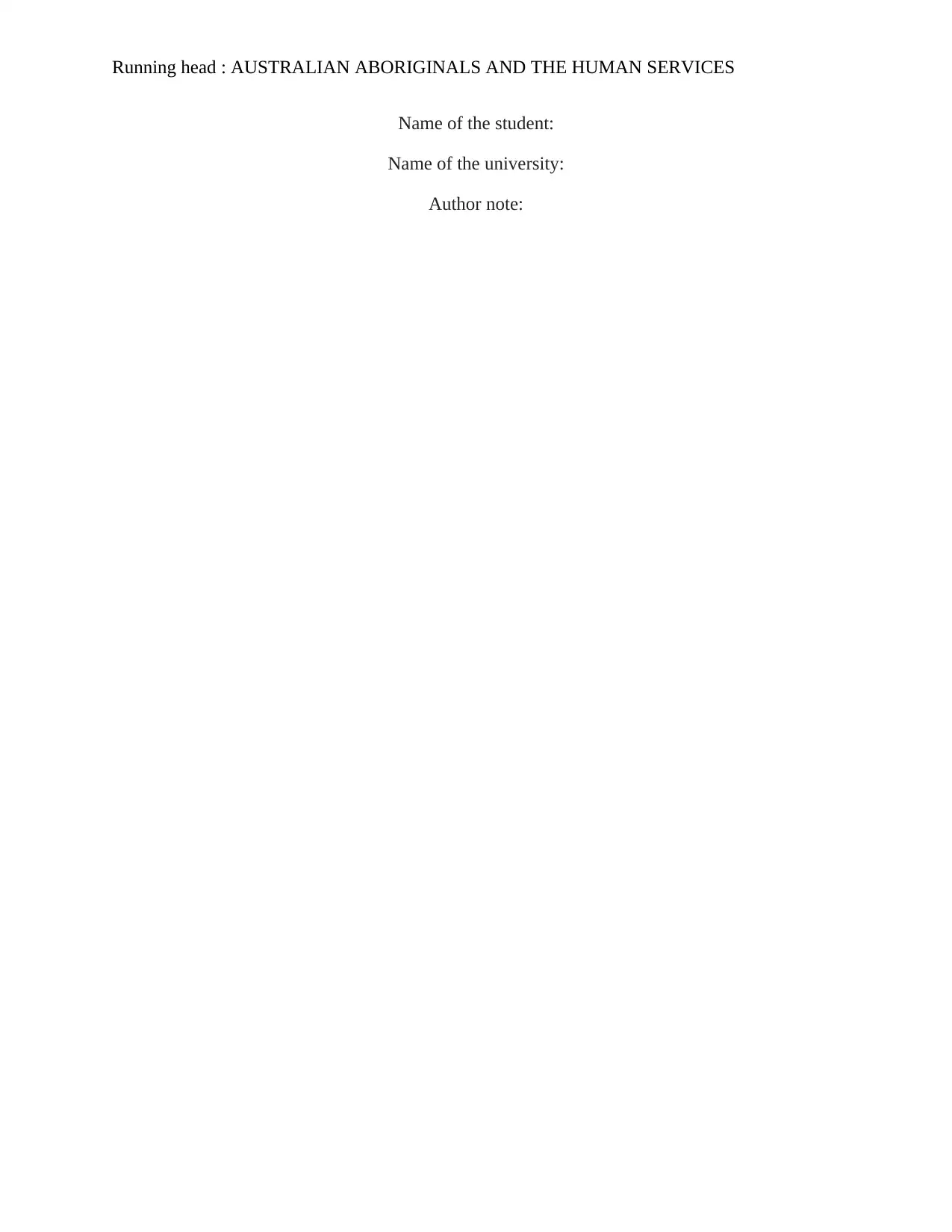
Running head : AUSTRALIAN ABORIGINALS AND THE HUMAN SERVICES
Name of the student:
Name of the university:
Author note:
Name of the student:
Name of the university:
Author note:
Paraphrase This Document
Need a fresh take? Get an instant paraphrase of this document with our AI Paraphraser
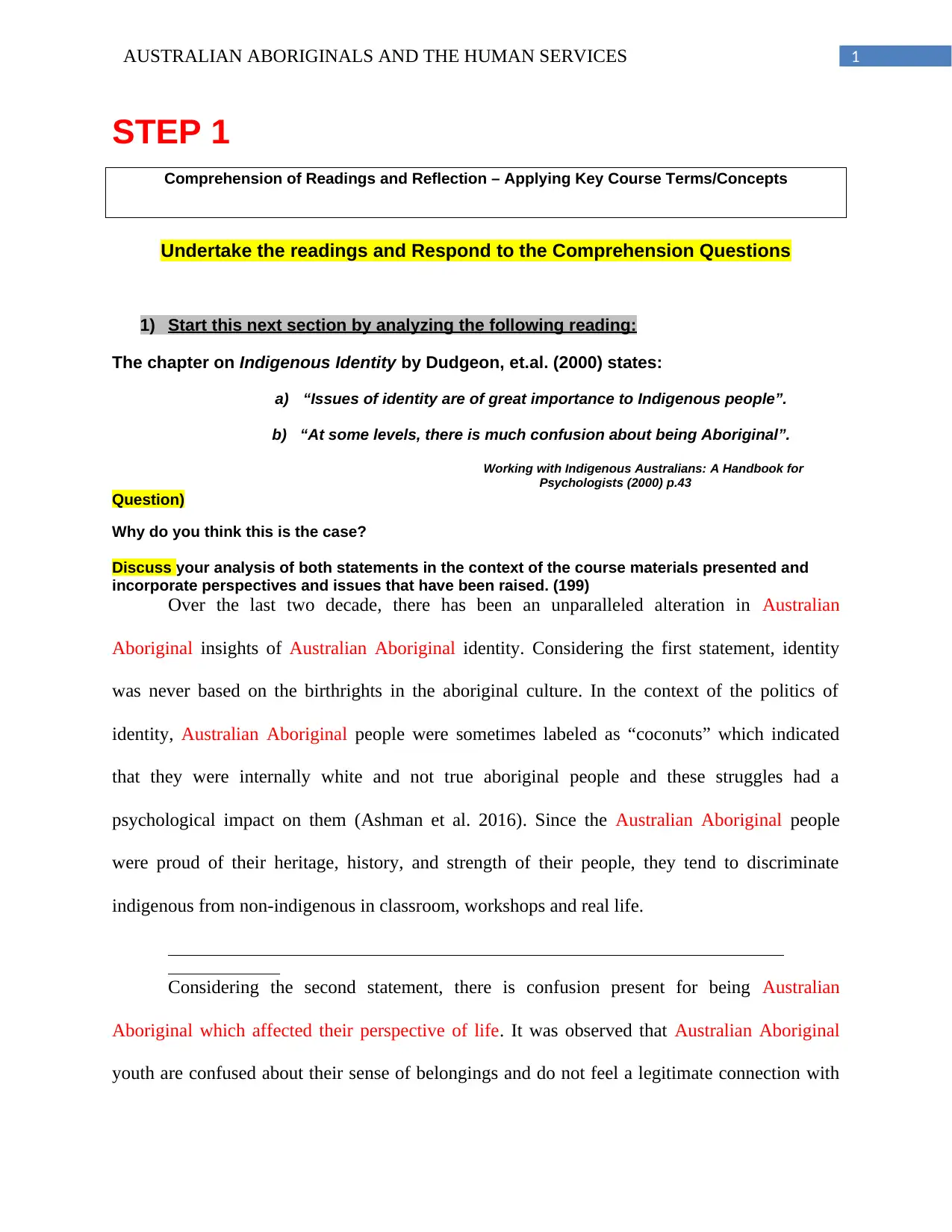
1AUSTRALIAN ABORIGINALS AND THE HUMAN SERVICES
STEP 1
Comprehension of Readings and Reflection – Applying Key Course Terms/Concepts
Undertake the readings and Respond to the Comprehension Questions
1) Start this next section by analyzing the following reading:
The chapter on Indigenous Identity by Dudgeon, et.al. (2000) states:
a) “Issues of identity are of great importance to Indigenous people”.
b) “At some levels, there is much confusion about being Aboriginal”.
Working with Indigenous Australians: A Handbook for
Psychologists (2000) p.43
Question)
Why do you think this is the case?
Discuss your analysis of both statements in the context of the course materials presented and
incorporate perspectives and issues that have been raised. (199)
Over the last two decade, there has been an unparalleled alteration in Australian
Aboriginal insights of Australian Aboriginal identity. Considering the first statement, identity
was never based on the birthrights in the aboriginal culture. In the context of the politics of
identity, Australian Aboriginal people were sometimes labeled as “coconuts” which indicated
that they were internally white and not true aboriginal people and these struggles had a
psychological impact on them (Ashman et al. 2016). Since the Australian Aboriginal people
were proud of their heritage, history, and strength of their people, they tend to discriminate
indigenous from non-indigenous in classroom, workshops and real life.
Considering the second statement, there is confusion present for being Australian
Aboriginal which affected their perspective of life. It was observed that Australian Aboriginal
youth are confused about their sense of belongings and do not feel a legitimate connection with
STEP 1
Comprehension of Readings and Reflection – Applying Key Course Terms/Concepts
Undertake the readings and Respond to the Comprehension Questions
1) Start this next section by analyzing the following reading:
The chapter on Indigenous Identity by Dudgeon, et.al. (2000) states:
a) “Issues of identity are of great importance to Indigenous people”.
b) “At some levels, there is much confusion about being Aboriginal”.
Working with Indigenous Australians: A Handbook for
Psychologists (2000) p.43
Question)
Why do you think this is the case?
Discuss your analysis of both statements in the context of the course materials presented and
incorporate perspectives and issues that have been raised. (199)
Over the last two decade, there has been an unparalleled alteration in Australian
Aboriginal insights of Australian Aboriginal identity. Considering the first statement, identity
was never based on the birthrights in the aboriginal culture. In the context of the politics of
identity, Australian Aboriginal people were sometimes labeled as “coconuts” which indicated
that they were internally white and not true aboriginal people and these struggles had a
psychological impact on them (Ashman et al. 2016). Since the Australian Aboriginal people
were proud of their heritage, history, and strength of their people, they tend to discriminate
indigenous from non-indigenous in classroom, workshops and real life.
Considering the second statement, there is confusion present for being Australian
Aboriginal which affected their perspective of life. It was observed that Australian Aboriginal
youth are confused about their sense of belongings and do not feel a legitimate connection with
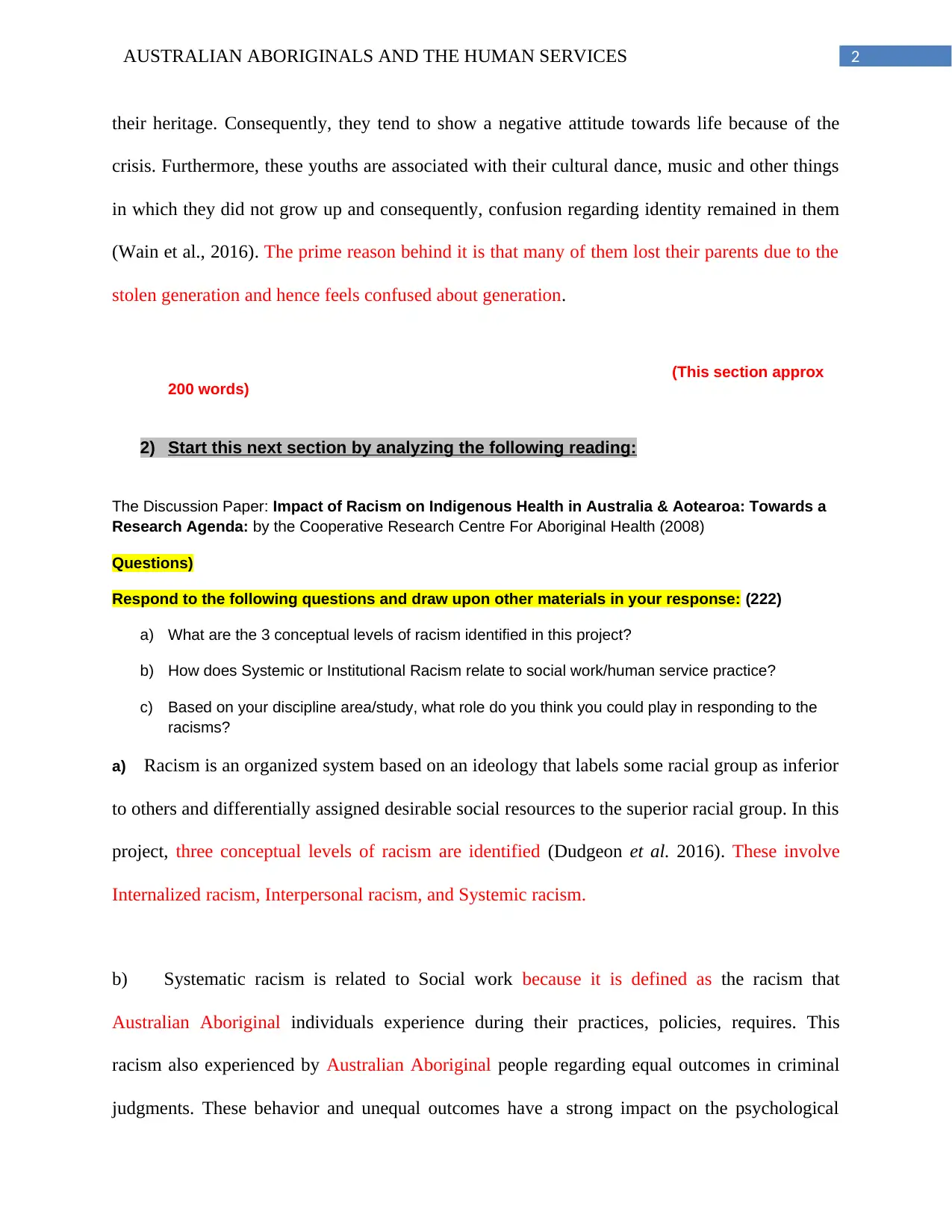
2AUSTRALIAN ABORIGINALS AND THE HUMAN SERVICES
their heritage. Consequently, they tend to show a negative attitude towards life because of the
crisis. Furthermore, these youths are associated with their cultural dance, music and other things
in which they did not grow up and consequently, confusion regarding identity remained in them
(Wain et al., 2016). The prime reason behind it is that many of them lost their parents due to the
stolen generation and hence feels confused about generation.
(This section approx
200 words)
2) Start this next section by analyzing the following reading:
The Discussion Paper: Impact of Racism on Indigenous Health in Australia & Aotearoa: Towards a
Research Agenda: by the Cooperative Research Centre For Aboriginal Health (2008)
Questions)
Respond to the following questions and draw upon other materials in your response: (222)
a) What are the 3 conceptual levels of racism identified in this project?
b) How does Systemic or Institutional Racism relate to social work/human service practice?
c) Based on your discipline area/study, what role do you think you could play in responding to the
racisms?
a) Racism is an organized system based on an ideology that labels some racial group as inferior
to others and differentially assigned desirable social resources to the superior racial group. In this
project, three conceptual levels of racism are identified (Dudgeon et al. 2016). These involve
Internalized racism, Interpersonal racism, and Systemic racism.
b) Systematic racism is related to Social work because it is defined as the racism that
Australian Aboriginal individuals experience during their practices, policies, requires. This
racism also experienced by Australian Aboriginal people regarding equal outcomes in criminal
judgments. These behavior and unequal outcomes have a strong impact on the psychological
their heritage. Consequently, they tend to show a negative attitude towards life because of the
crisis. Furthermore, these youths are associated with their cultural dance, music and other things
in which they did not grow up and consequently, confusion regarding identity remained in them
(Wain et al., 2016). The prime reason behind it is that many of them lost their parents due to the
stolen generation and hence feels confused about generation.
(This section approx
200 words)
2) Start this next section by analyzing the following reading:
The Discussion Paper: Impact of Racism on Indigenous Health in Australia & Aotearoa: Towards a
Research Agenda: by the Cooperative Research Centre For Aboriginal Health (2008)
Questions)
Respond to the following questions and draw upon other materials in your response: (222)
a) What are the 3 conceptual levels of racism identified in this project?
b) How does Systemic or Institutional Racism relate to social work/human service practice?
c) Based on your discipline area/study, what role do you think you could play in responding to the
racisms?
a) Racism is an organized system based on an ideology that labels some racial group as inferior
to others and differentially assigned desirable social resources to the superior racial group. In this
project, three conceptual levels of racism are identified (Dudgeon et al. 2016). These involve
Internalized racism, Interpersonal racism, and Systemic racism.
b) Systematic racism is related to Social work because it is defined as the racism that
Australian Aboriginal individuals experience during their practices, policies, requires. This
racism also experienced by Australian Aboriginal people regarding equal outcomes in criminal
judgments. These behavior and unequal outcomes have a strong impact on the psychological
⊘ This is a preview!⊘
Do you want full access?
Subscribe today to unlock all pages.

Trusted by 1+ million students worldwide
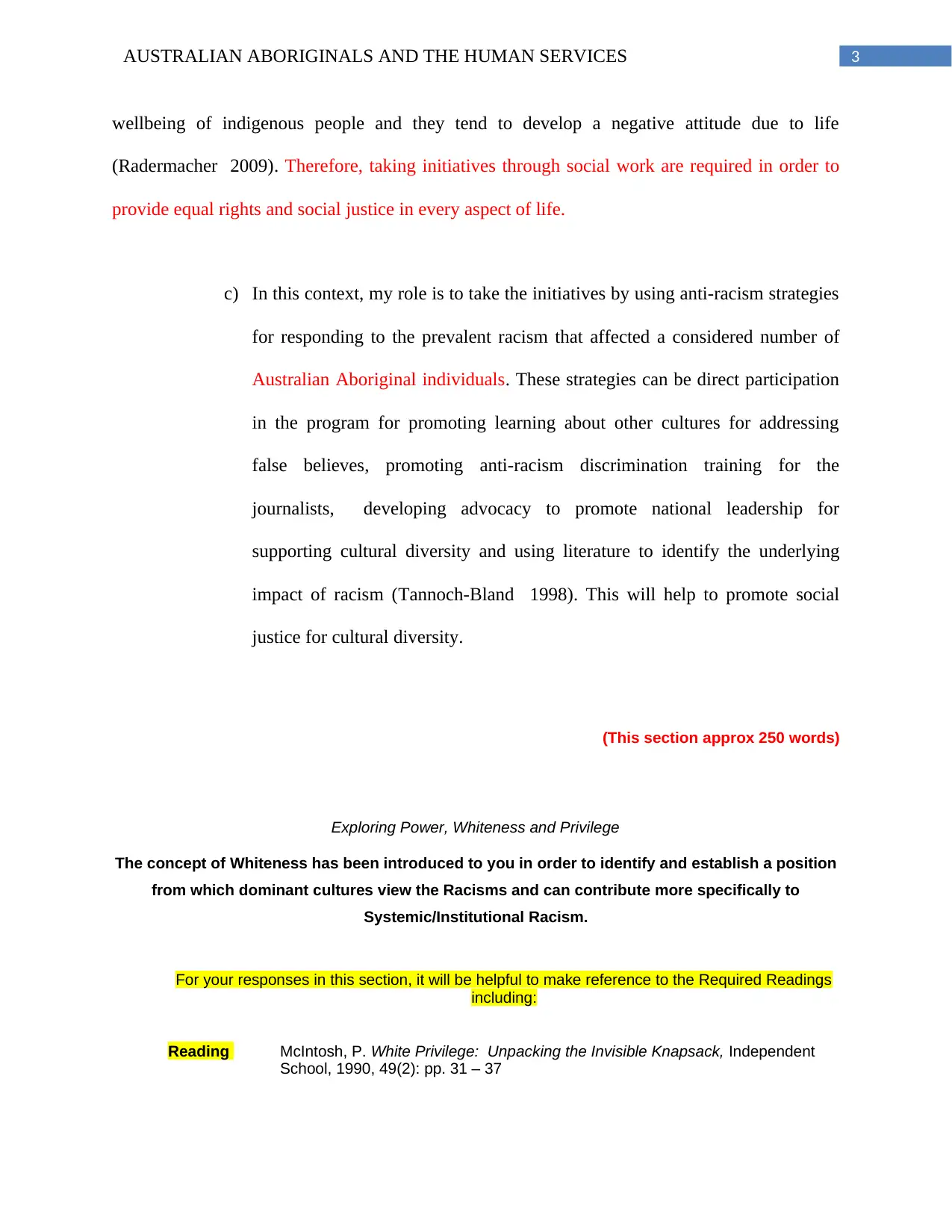
3AUSTRALIAN ABORIGINALS AND THE HUMAN SERVICES
wellbeing of indigenous people and they tend to develop a negative attitude due to life
(Radermacher 2009). Therefore, taking initiatives through social work are required in order to
provide equal rights and social justice in every aspect of life.
c) In this context, my role is to take the initiatives by using anti-racism strategies
for responding to the prevalent racism that affected a considered number of
Australian Aboriginal individuals. These strategies can be direct participation
in the program for promoting learning about other cultures for addressing
false believes, promoting anti-racism discrimination training for the
journalists, developing advocacy to promote national leadership for
supporting cultural diversity and using literature to identify the underlying
impact of racism (Tannoch-Bland 1998). This will help to promote social
justice for cultural diversity.
(This section approx 250 words)
Exploring Power, Whiteness and Privilege
The concept of Whiteness has been introduced to you in order to identify and establish a position
from which dominant cultures view the Racisms and can contribute more specifically to
Systemic/Institutional Racism.
For your responses in this section, it will be helpful to make reference to the Required Readings
including:
Reading McIntosh, P. White Privilege: Unpacking the Invisible Knapsack, Independent
School, 1990, 49(2): pp. 31 – 37
wellbeing of indigenous people and they tend to develop a negative attitude due to life
(Radermacher 2009). Therefore, taking initiatives through social work are required in order to
provide equal rights and social justice in every aspect of life.
c) In this context, my role is to take the initiatives by using anti-racism strategies
for responding to the prevalent racism that affected a considered number of
Australian Aboriginal individuals. These strategies can be direct participation
in the program for promoting learning about other cultures for addressing
false believes, promoting anti-racism discrimination training for the
journalists, developing advocacy to promote national leadership for
supporting cultural diversity and using literature to identify the underlying
impact of racism (Tannoch-Bland 1998). This will help to promote social
justice for cultural diversity.
(This section approx 250 words)
Exploring Power, Whiteness and Privilege
The concept of Whiteness has been introduced to you in order to identify and establish a position
from which dominant cultures view the Racisms and can contribute more specifically to
Systemic/Institutional Racism.
For your responses in this section, it will be helpful to make reference to the Required Readings
including:
Reading McIntosh, P. White Privilege: Unpacking the Invisible Knapsack, Independent
School, 1990, 49(2): pp. 31 – 37
Paraphrase This Document
Need a fresh take? Get an instant paraphrase of this document with our AI Paraphraser
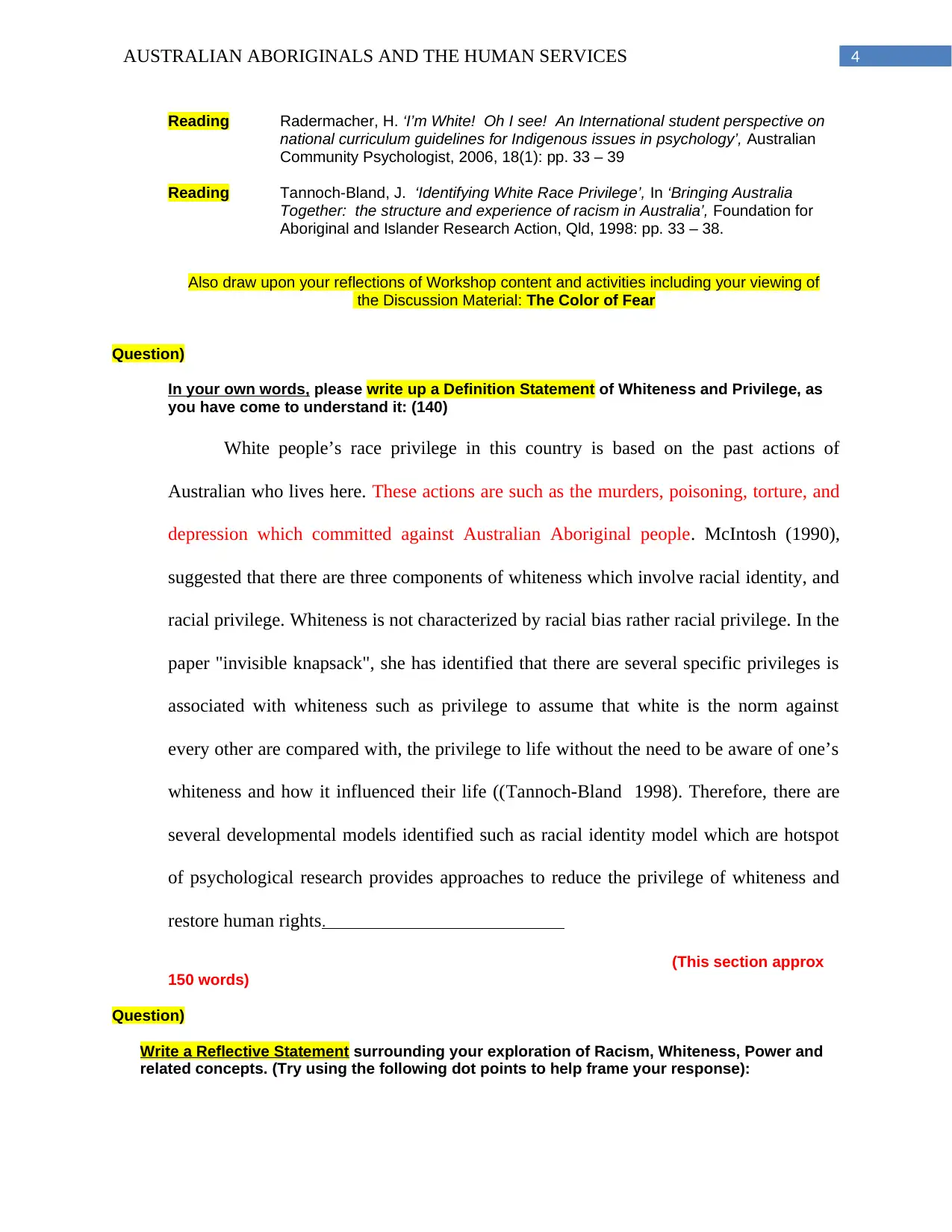
4AUSTRALIAN ABORIGINALS AND THE HUMAN SERVICES
Reading Radermacher, H. ‘I’m White! Oh I see! An International student perspective on
national curriculum guidelines for Indigenous issues in psychology’, Australian
Community Psychologist, 2006, 18(1): pp. 33 – 39
Reading Tannoch-Bland, J. ‘Identifying White Race Privilege’, In ‘Bringing Australia
Together: the structure and experience of racism in Australia’, Foundation for
Aboriginal and Islander Research Action, Qld, 1998: pp. 33 – 38.
Also draw upon your reflections of Workshop content and activities including your viewing of
the Discussion Material: The Color of Fear
Question)
In your own words, please write up a Definition Statement of Whiteness and Privilege, as
you have come to understand it: (140)
White people’s race privilege in this country is based on the past actions of
Australian who lives here. These actions are such as the murders, poisoning, torture, and
depression which committed against Australian Aboriginal people. McIntosh (1990),
suggested that there are three components of whiteness which involve racial identity, and
racial privilege. Whiteness is not characterized by racial bias rather racial privilege. In the
paper "invisible knapsack", she has identified that there are several specific privileges is
associated with whiteness such as privilege to assume that white is the norm against
every other are compared with, the privilege to life without the need to be aware of one’s
whiteness and how it influenced their life ((Tannoch-Bland 1998). Therefore, there are
several developmental models identified such as racial identity model which are hotspot
of psychological research provides approaches to reduce the privilege of whiteness and
restore human rights.
(This section approx
150 words)
Question)
Write a Reflective Statement surrounding your exploration of Racism, Whiteness, Power and
related concepts. (Try using the following dot points to help frame your response):
Reading Radermacher, H. ‘I’m White! Oh I see! An International student perspective on
national curriculum guidelines for Indigenous issues in psychology’, Australian
Community Psychologist, 2006, 18(1): pp. 33 – 39
Reading Tannoch-Bland, J. ‘Identifying White Race Privilege’, In ‘Bringing Australia
Together: the structure and experience of racism in Australia’, Foundation for
Aboriginal and Islander Research Action, Qld, 1998: pp. 33 – 38.
Also draw upon your reflections of Workshop content and activities including your viewing of
the Discussion Material: The Color of Fear
Question)
In your own words, please write up a Definition Statement of Whiteness and Privilege, as
you have come to understand it: (140)
White people’s race privilege in this country is based on the past actions of
Australian who lives here. These actions are such as the murders, poisoning, torture, and
depression which committed against Australian Aboriginal people. McIntosh (1990),
suggested that there are three components of whiteness which involve racial identity, and
racial privilege. Whiteness is not characterized by racial bias rather racial privilege. In the
paper "invisible knapsack", she has identified that there are several specific privileges is
associated with whiteness such as privilege to assume that white is the norm against
every other are compared with, the privilege to life without the need to be aware of one’s
whiteness and how it influenced their life ((Tannoch-Bland 1998). Therefore, there are
several developmental models identified such as racial identity model which are hotspot
of psychological research provides approaches to reduce the privilege of whiteness and
restore human rights.
(This section approx
150 words)
Question)
Write a Reflective Statement surrounding your exploration of Racism, Whiteness, Power and
related concepts. (Try using the following dot points to help frame your response):

5AUSTRALIAN ABORIGINALS AND THE HUMAN SERVICES
Was Whiteness and Privilege easy to define in your own context and in the context of the
profession?
If not, why?
How did these concepts and the discussion challenge your thinking?
Examine and discuss any clarity, and/or discomfort you may have experienced with the
concepts and literature
What conclusions you have drawn at this point in your learning?
1. Whiteness and privilege are not easy to define in my own context and in my
professional context. White race privilege is invisible, unlearnt, denied systematic and
undesirable dominance that promote inferiority and discrimination amongst human being.
Consequently, these discriminating are the origin of murder; positioning and torture
where power belongs to the white race because of the privilege of whiteness and victim
were indigenous people (O’Sullivan et al. 2016). Therefore in the professional context as
a social worker, the concept of whiteness and privilege make it difficult to promote
culturally competent services throughout Australia.
2. These concepts and discussion regarding whiteness and privilege changed my
thinking and I have experienced discomfort with the concepts and literature. The
underlying reason behind it is that Whiteness is often considered as a privilege that is
enjoyed rather than acknowledged which affected other ethnic groups (Came et al. 2016).
The existence of this privilege as a racial identity further provides the white people a
dominant position in society that also reflects in the classroom. It is accepted as a while
other ethnicities are devalued. Therefore, the Australian Aboriginal or other ethnicity
experienced inequalities regarding every aspect of life.
3. From this point of learning, I can conclude that the privilege of whiteness not only
provide the power to the white people but also affected the mental and physical wellbeing
Was Whiteness and Privilege easy to define in your own context and in the context of the
profession?
If not, why?
How did these concepts and the discussion challenge your thinking?
Examine and discuss any clarity, and/or discomfort you may have experienced with the
concepts and literature
What conclusions you have drawn at this point in your learning?
1. Whiteness and privilege are not easy to define in my own context and in my
professional context. White race privilege is invisible, unlearnt, denied systematic and
undesirable dominance that promote inferiority and discrimination amongst human being.
Consequently, these discriminating are the origin of murder; positioning and torture
where power belongs to the white race because of the privilege of whiteness and victim
were indigenous people (O’Sullivan et al. 2016). Therefore in the professional context as
a social worker, the concept of whiteness and privilege make it difficult to promote
culturally competent services throughout Australia.
2. These concepts and discussion regarding whiteness and privilege changed my
thinking and I have experienced discomfort with the concepts and literature. The
underlying reason behind it is that Whiteness is often considered as a privilege that is
enjoyed rather than acknowledged which affected other ethnic groups (Came et al. 2016).
The existence of this privilege as a racial identity further provides the white people a
dominant position in society that also reflects in the classroom. It is accepted as a while
other ethnicities are devalued. Therefore, the Australian Aboriginal or other ethnicity
experienced inequalities regarding every aspect of life.
3. From this point of learning, I can conclude that the privilege of whiteness not only
provide the power to the white people but also affected the mental and physical wellbeing
⊘ This is a preview!⊘
Do you want full access?
Subscribe today to unlock all pages.

Trusted by 1+ million students worldwide
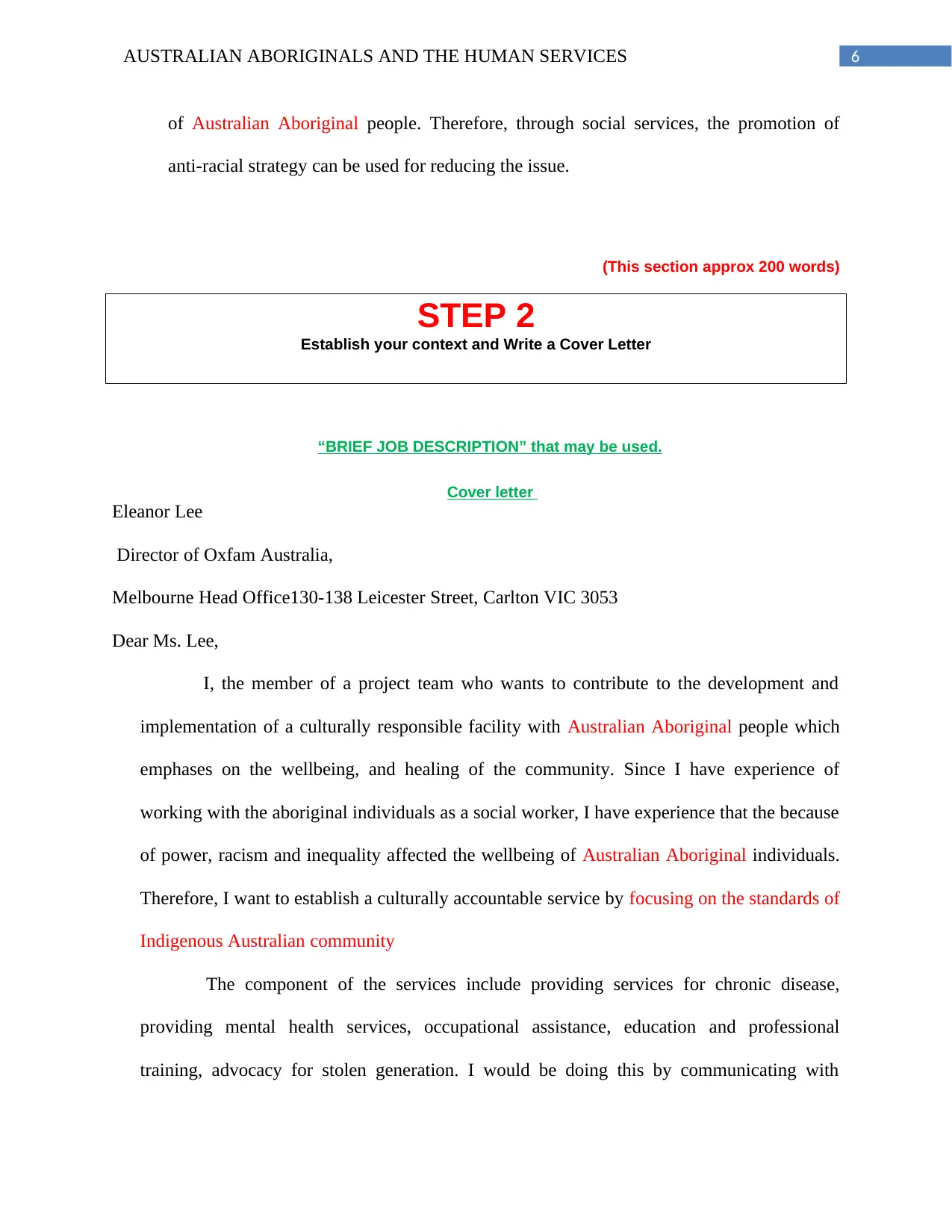
6AUSTRALIAN ABORIGINALS AND THE HUMAN SERVICES
of Australian Aboriginal people. Therefore, through social services, the promotion of
anti-racial strategy can be used for reducing the issue.
(This section approx 200 words)
STEP 2
Establish your context and Write a Cover Letter
“BRIEF JOB DESCRIPTION” that may be used.
Cover letter
Eleanor Lee
Director of Oxfam Australia,
Melbourne Head Office130-138 Leicester Street, Carlton VIC 3053
Dear Ms. Lee,
I, the member of a project team who wants to contribute to the development and
implementation of a culturally responsible facility with Australian Aboriginal people which
emphases on the wellbeing, and healing of the community. Since I have experience of
working with the aboriginal individuals as a social worker, I have experience that the because
of power, racism and inequality affected the wellbeing of Australian Aboriginal individuals.
Therefore, I want to establish a culturally accountable service by focusing on the standards of
Indigenous Australian community
The component of the services include providing services for chronic disease,
providing mental health services, occupational assistance, education and professional
training, advocacy for stolen generation. I would be doing this by communicating with
of Australian Aboriginal people. Therefore, through social services, the promotion of
anti-racial strategy can be used for reducing the issue.
(This section approx 200 words)
STEP 2
Establish your context and Write a Cover Letter
“BRIEF JOB DESCRIPTION” that may be used.
Cover letter
Eleanor Lee
Director of Oxfam Australia,
Melbourne Head Office130-138 Leicester Street, Carlton VIC 3053
Dear Ms. Lee,
I, the member of a project team who wants to contribute to the development and
implementation of a culturally responsible facility with Australian Aboriginal people which
emphases on the wellbeing, and healing of the community. Since I have experience of
working with the aboriginal individuals as a social worker, I have experience that the because
of power, racism and inequality affected the wellbeing of Australian Aboriginal individuals.
Therefore, I want to establish a culturally accountable service by focusing on the standards of
Indigenous Australian community
The component of the services include providing services for chronic disease,
providing mental health services, occupational assistance, education and professional
training, advocacy for stolen generation. I would be doing this by communicating with
Paraphrase This Document
Need a fresh take? Get an instant paraphrase of this document with our AI Paraphraser
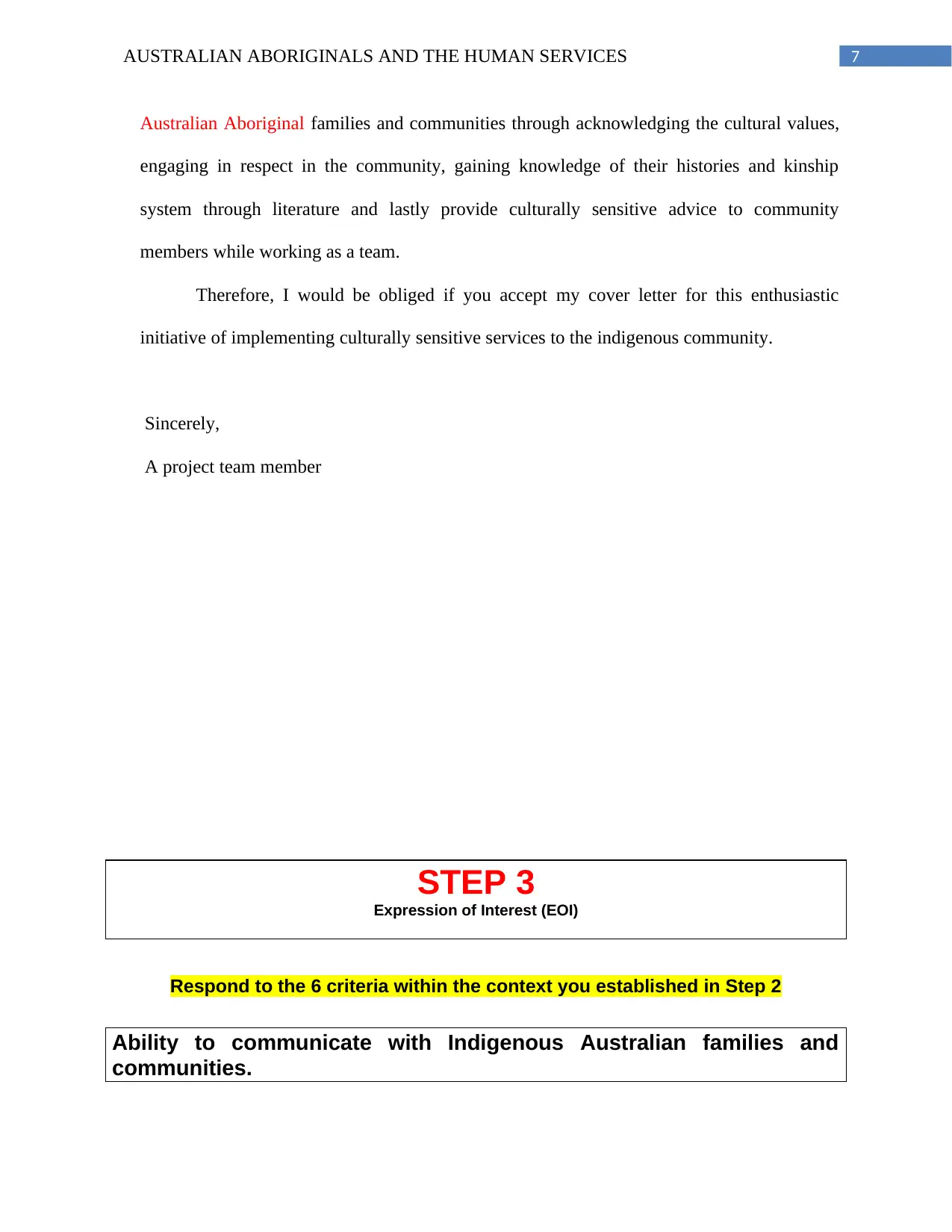
7AUSTRALIAN ABORIGINALS AND THE HUMAN SERVICES
Australian Aboriginal families and communities through acknowledging the cultural values,
engaging in respect in the community, gaining knowledge of their histories and kinship
system through literature and lastly provide culturally sensitive advice to community
members while working as a team.
Therefore, I would be obliged if you accept my cover letter for this enthusiastic
initiative of implementing culturally sensitive services to the indigenous community.
Sincerely,
A project team member
STEP 3
Expression of Interest (EOI)
Respond to the 6 criteria within the context you established in Step 2
Ability to communicate with Indigenous Australian families and
communities.
Australian Aboriginal families and communities through acknowledging the cultural values,
engaging in respect in the community, gaining knowledge of their histories and kinship
system through literature and lastly provide culturally sensitive advice to community
members while working as a team.
Therefore, I would be obliged if you accept my cover letter for this enthusiastic
initiative of implementing culturally sensitive services to the indigenous community.
Sincerely,
A project team member
STEP 3
Expression of Interest (EOI)
Respond to the 6 criteria within the context you established in Step 2
Ability to communicate with Indigenous Australian families and
communities.
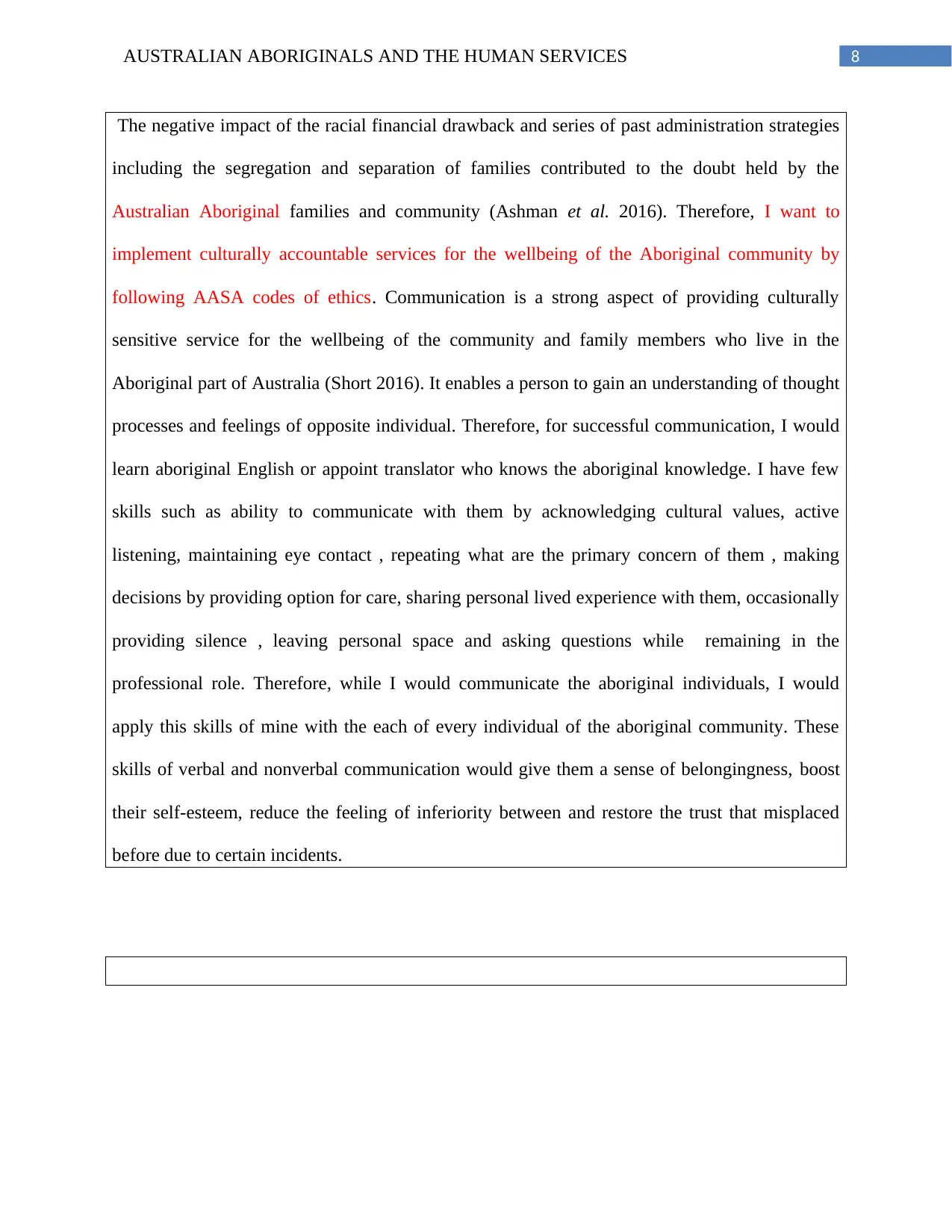
8AUSTRALIAN ABORIGINALS AND THE HUMAN SERVICES
The negative impact of the racial financial drawback and series of past administration strategies
including the segregation and separation of families contributed to the doubt held by the
Australian Aboriginal families and community (Ashman et al. 2016). Therefore, I want to
implement culturally accountable services for the wellbeing of the Aboriginal community by
following AASA codes of ethics. Communication is a strong aspect of providing culturally
sensitive service for the wellbeing of the community and family members who live in the
Aboriginal part of Australia (Short 2016). It enables a person to gain an understanding of thought
processes and feelings of opposite individual. Therefore, for successful communication, I would
learn aboriginal English or appoint translator who knows the aboriginal knowledge. I have few
skills such as ability to communicate with them by acknowledging cultural values, active
listening, maintaining eye contact , repeating what are the primary concern of them , making
decisions by providing option for care, sharing personal lived experience with them, occasionally
providing silence , leaving personal space and asking questions while remaining in the
professional role. Therefore, while I would communicate the aboriginal individuals, I would
apply this skills of mine with the each of every individual of the aboriginal community. These
skills of verbal and nonverbal communication would give them a sense of belongingness, boost
their self-esteem, reduce the feeling of inferiority between and restore the trust that misplaced
before due to certain incidents.
The negative impact of the racial financial drawback and series of past administration strategies
including the segregation and separation of families contributed to the doubt held by the
Australian Aboriginal families and community (Ashman et al. 2016). Therefore, I want to
implement culturally accountable services for the wellbeing of the Aboriginal community by
following AASA codes of ethics. Communication is a strong aspect of providing culturally
sensitive service for the wellbeing of the community and family members who live in the
Aboriginal part of Australia (Short 2016). It enables a person to gain an understanding of thought
processes and feelings of opposite individual. Therefore, for successful communication, I would
learn aboriginal English or appoint translator who knows the aboriginal knowledge. I have few
skills such as ability to communicate with them by acknowledging cultural values, active
listening, maintaining eye contact , repeating what are the primary concern of them , making
decisions by providing option for care, sharing personal lived experience with them, occasionally
providing silence , leaving personal space and asking questions while remaining in the
professional role. Therefore, while I would communicate the aboriginal individuals, I would
apply this skills of mine with the each of every individual of the aboriginal community. These
skills of verbal and nonverbal communication would give them a sense of belongingness, boost
their self-esteem, reduce the feeling of inferiority between and restore the trust that misplaced
before due to certain incidents.
⊘ This is a preview!⊘
Do you want full access?
Subscribe today to unlock all pages.

Trusted by 1+ million students worldwide
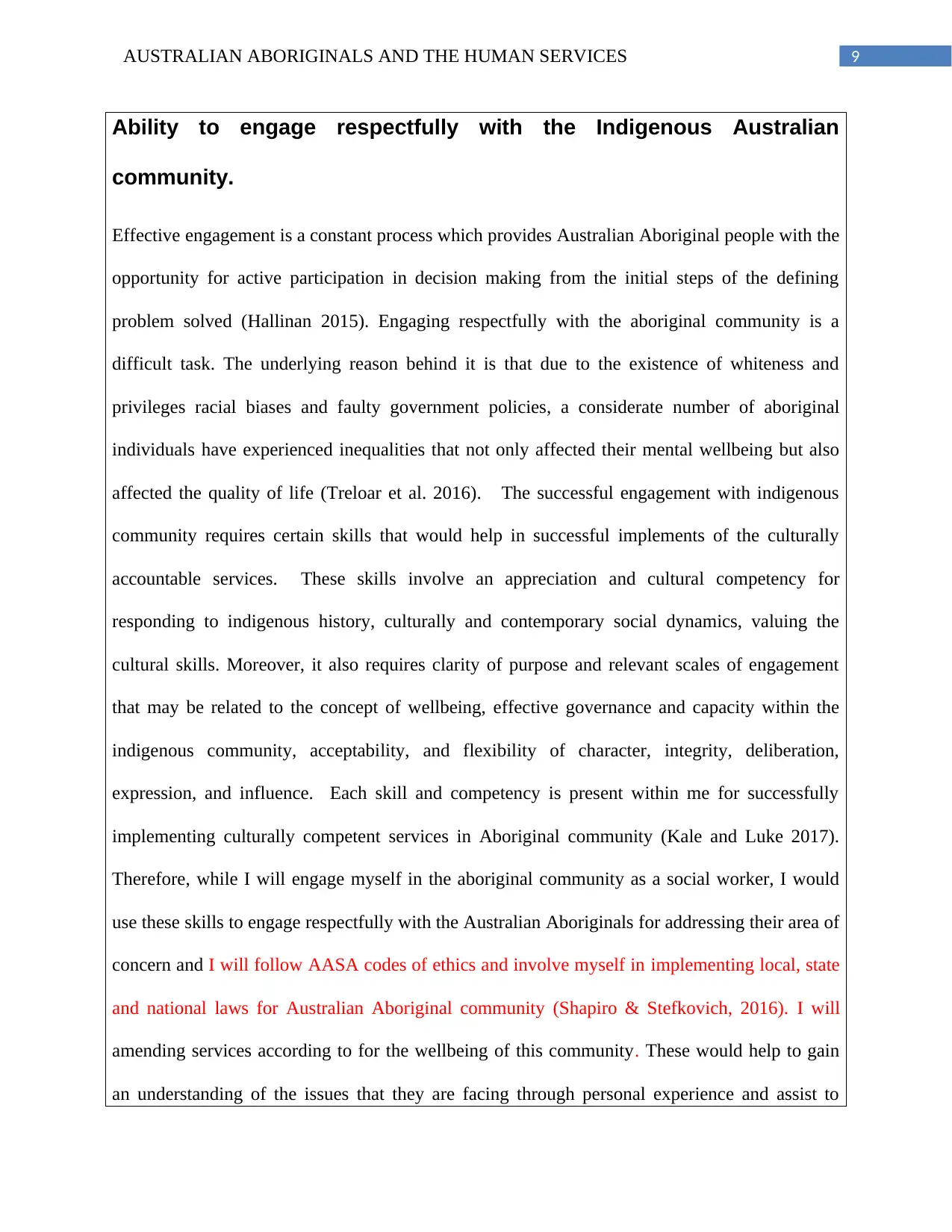
9AUSTRALIAN ABORIGINALS AND THE HUMAN SERVICES
Ability to engage respectfully with the Indigenous Australian
community.
Effective engagement is a constant process which provides Australian Aboriginal people with the
opportunity for active participation in decision making from the initial steps of the defining
problem solved (Hallinan 2015). Engaging respectfully with the aboriginal community is a
difficult task. The underlying reason behind it is that due to the existence of whiteness and
privileges racial biases and faulty government policies, a considerate number of aboriginal
individuals have experienced inequalities that not only affected their mental wellbeing but also
affected the quality of life (Treloar et al. 2016). The successful engagement with indigenous
community requires certain skills that would help in successful implements of the culturally
accountable services. These skills involve an appreciation and cultural competency for
responding to indigenous history, culturally and contemporary social dynamics, valuing the
cultural skills. Moreover, it also requires clarity of purpose and relevant scales of engagement
that may be related to the concept of wellbeing, effective governance and capacity within the
indigenous community, acceptability, and flexibility of character, integrity, deliberation,
expression, and influence. Each skill and competency is present within me for successfully
implementing culturally competent services in Aboriginal community (Kale and Luke 2017).
Therefore, while I will engage myself in the aboriginal community as a social worker, I would
use these skills to engage respectfully with the Australian Aboriginals for addressing their area of
concern and I will follow AASA codes of ethics and involve myself in implementing local, state
and national laws for Australian Aboriginal community (Shapiro & Stefkovich, 2016). I will
amending services according to for the wellbeing of this community. These would help to gain
an understanding of the issues that they are facing through personal experience and assist to
Ability to engage respectfully with the Indigenous Australian
community.
Effective engagement is a constant process which provides Australian Aboriginal people with the
opportunity for active participation in decision making from the initial steps of the defining
problem solved (Hallinan 2015). Engaging respectfully with the aboriginal community is a
difficult task. The underlying reason behind it is that due to the existence of whiteness and
privileges racial biases and faulty government policies, a considerate number of aboriginal
individuals have experienced inequalities that not only affected their mental wellbeing but also
affected the quality of life (Treloar et al. 2016). The successful engagement with indigenous
community requires certain skills that would help in successful implements of the culturally
accountable services. These skills involve an appreciation and cultural competency for
responding to indigenous history, culturally and contemporary social dynamics, valuing the
cultural skills. Moreover, it also requires clarity of purpose and relevant scales of engagement
that may be related to the concept of wellbeing, effective governance and capacity within the
indigenous community, acceptability, and flexibility of character, integrity, deliberation,
expression, and influence. Each skill and competency is present within me for successfully
implementing culturally competent services in Aboriginal community (Kale and Luke 2017).
Therefore, while I will engage myself in the aboriginal community as a social worker, I would
use these skills to engage respectfully with the Australian Aboriginals for addressing their area of
concern and I will follow AASA codes of ethics and involve myself in implementing local, state
and national laws for Australian Aboriginal community (Shapiro & Stefkovich, 2016). I will
amending services according to for the wellbeing of this community. These would help to gain
an understanding of the issues that they are facing through personal experience and assist to
Paraphrase This Document
Need a fresh take? Get an instant paraphrase of this document with our AI Paraphraser
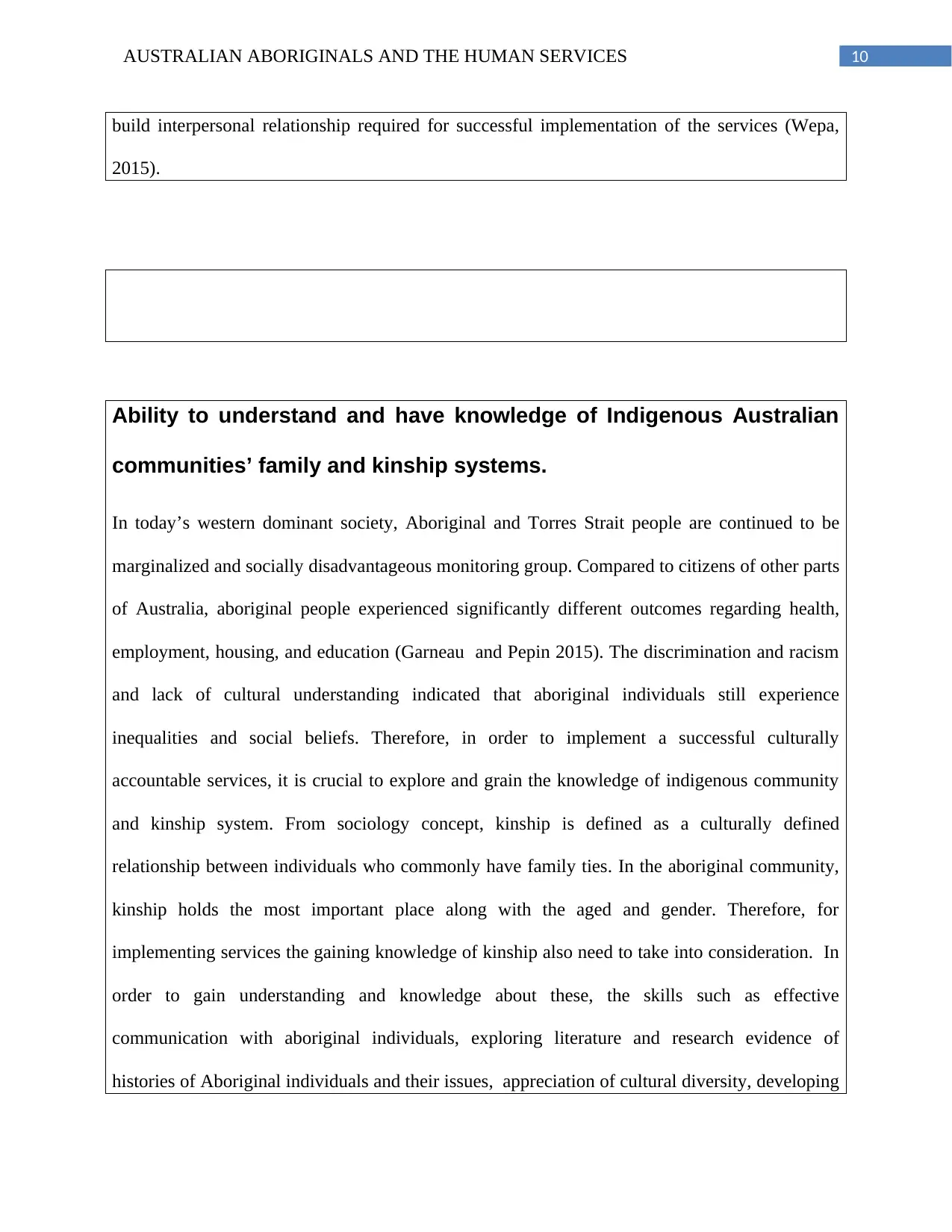
10AUSTRALIAN ABORIGINALS AND THE HUMAN SERVICES
build interpersonal relationship required for successful implementation of the services (Wepa,
2015).
Ability to understand and have knowledge of Indigenous Australian
communities’ family and kinship systems.
In today’s western dominant society, Aboriginal and Torres Strait people are continued to be
marginalized and socially disadvantageous monitoring group. Compared to citizens of other parts
of Australia, aboriginal people experienced significantly different outcomes regarding health,
employment, housing, and education (Garneau and Pepin 2015). The discrimination and racism
and lack of cultural understanding indicated that aboriginal individuals still experience
inequalities and social beliefs. Therefore, in order to implement a successful culturally
accountable services, it is crucial to explore and grain the knowledge of indigenous community
and kinship system. From sociology concept, kinship is defined as a culturally defined
relationship between individuals who commonly have family ties. In the aboriginal community,
kinship holds the most important place along with the aged and gender. Therefore, for
implementing services the gaining knowledge of kinship also need to take into consideration. In
order to gain understanding and knowledge about these, the skills such as effective
communication with aboriginal individuals, exploring literature and research evidence of
histories of Aboriginal individuals and their issues, appreciation of cultural diversity, developing
build interpersonal relationship required for successful implementation of the services (Wepa,
2015).
Ability to understand and have knowledge of Indigenous Australian
communities’ family and kinship systems.
In today’s western dominant society, Aboriginal and Torres Strait people are continued to be
marginalized and socially disadvantageous monitoring group. Compared to citizens of other parts
of Australia, aboriginal people experienced significantly different outcomes regarding health,
employment, housing, and education (Garneau and Pepin 2015). The discrimination and racism
and lack of cultural understanding indicated that aboriginal individuals still experience
inequalities and social beliefs. Therefore, in order to implement a successful culturally
accountable services, it is crucial to explore and grain the knowledge of indigenous community
and kinship system. From sociology concept, kinship is defined as a culturally defined
relationship between individuals who commonly have family ties. In the aboriginal community,
kinship holds the most important place along with the aged and gender. Therefore, for
implementing services the gaining knowledge of kinship also need to take into consideration. In
order to gain understanding and knowledge about these, the skills such as effective
communication with aboriginal individuals, exploring literature and research evidence of
histories of Aboriginal individuals and their issues, appreciation of cultural diversity, developing
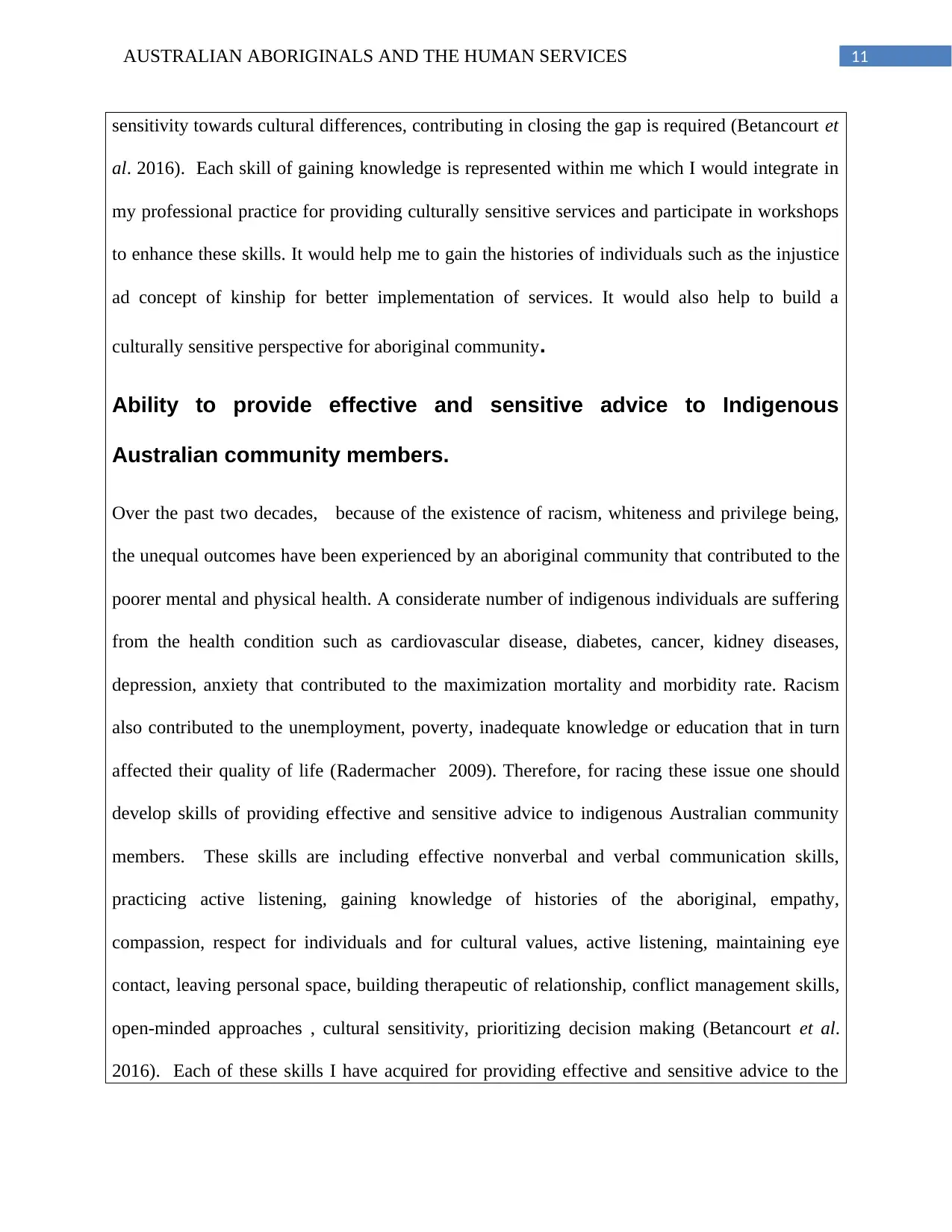
11AUSTRALIAN ABORIGINALS AND THE HUMAN SERVICES
sensitivity towards cultural differences, contributing in closing the gap is required (Betancourt et
al. 2016). Each skill of gaining knowledge is represented within me which I would integrate in
my professional practice for providing culturally sensitive services and participate in workshops
to enhance these skills. It would help me to gain the histories of individuals such as the injustice
ad concept of kinship for better implementation of services. It would also help to build a
culturally sensitive perspective for aboriginal community.
Ability to provide effective and sensitive advice to Indigenous
Australian community members.
Over the past two decades, because of the existence of racism, whiteness and privilege being,
the unequal outcomes have been experienced by an aboriginal community that contributed to the
poorer mental and physical health. A considerate number of indigenous individuals are suffering
from the health condition such as cardiovascular disease, diabetes, cancer, kidney diseases,
depression, anxiety that contributed to the maximization mortality and morbidity rate. Racism
also contributed to the unemployment, poverty, inadequate knowledge or education that in turn
affected their quality of life (Radermacher 2009). Therefore, for racing these issue one should
develop skills of providing effective and sensitive advice to indigenous Australian community
members. These skills are including effective nonverbal and verbal communication skills,
practicing active listening, gaining knowledge of histories of the aboriginal, empathy,
compassion, respect for individuals and for cultural values, active listening, maintaining eye
contact, leaving personal space, building therapeutic of relationship, conflict management skills,
open-minded approaches , cultural sensitivity, prioritizing decision making (Betancourt et al.
2016). Each of these skills I have acquired for providing effective and sensitive advice to the
sensitivity towards cultural differences, contributing in closing the gap is required (Betancourt et
al. 2016). Each skill of gaining knowledge is represented within me which I would integrate in
my professional practice for providing culturally sensitive services and participate in workshops
to enhance these skills. It would help me to gain the histories of individuals such as the injustice
ad concept of kinship for better implementation of services. It would also help to build a
culturally sensitive perspective for aboriginal community.
Ability to provide effective and sensitive advice to Indigenous
Australian community members.
Over the past two decades, because of the existence of racism, whiteness and privilege being,
the unequal outcomes have been experienced by an aboriginal community that contributed to the
poorer mental and physical health. A considerate number of indigenous individuals are suffering
from the health condition such as cardiovascular disease, diabetes, cancer, kidney diseases,
depression, anxiety that contributed to the maximization mortality and morbidity rate. Racism
also contributed to the unemployment, poverty, inadequate knowledge or education that in turn
affected their quality of life (Radermacher 2009). Therefore, for racing these issue one should
develop skills of providing effective and sensitive advice to indigenous Australian community
members. These skills are including effective nonverbal and verbal communication skills,
practicing active listening, gaining knowledge of histories of the aboriginal, empathy,
compassion, respect for individuals and for cultural values, active listening, maintaining eye
contact, leaving personal space, building therapeutic of relationship, conflict management skills,
open-minded approaches , cultural sensitivity, prioritizing decision making (Betancourt et al.
2016). Each of these skills I have acquired for providing effective and sensitive advice to the
⊘ This is a preview!⊘
Do you want full access?
Subscribe today to unlock all pages.

Trusted by 1+ million students worldwide
1 out of 18
Your All-in-One AI-Powered Toolkit for Academic Success.
+13062052269
info@desklib.com
Available 24*7 on WhatsApp / Email
![[object Object]](/_next/static/media/star-bottom.7253800d.svg)
Unlock your academic potential
Copyright © 2020–2025 A2Z Services. All Rights Reserved. Developed and managed by ZUCOL.

